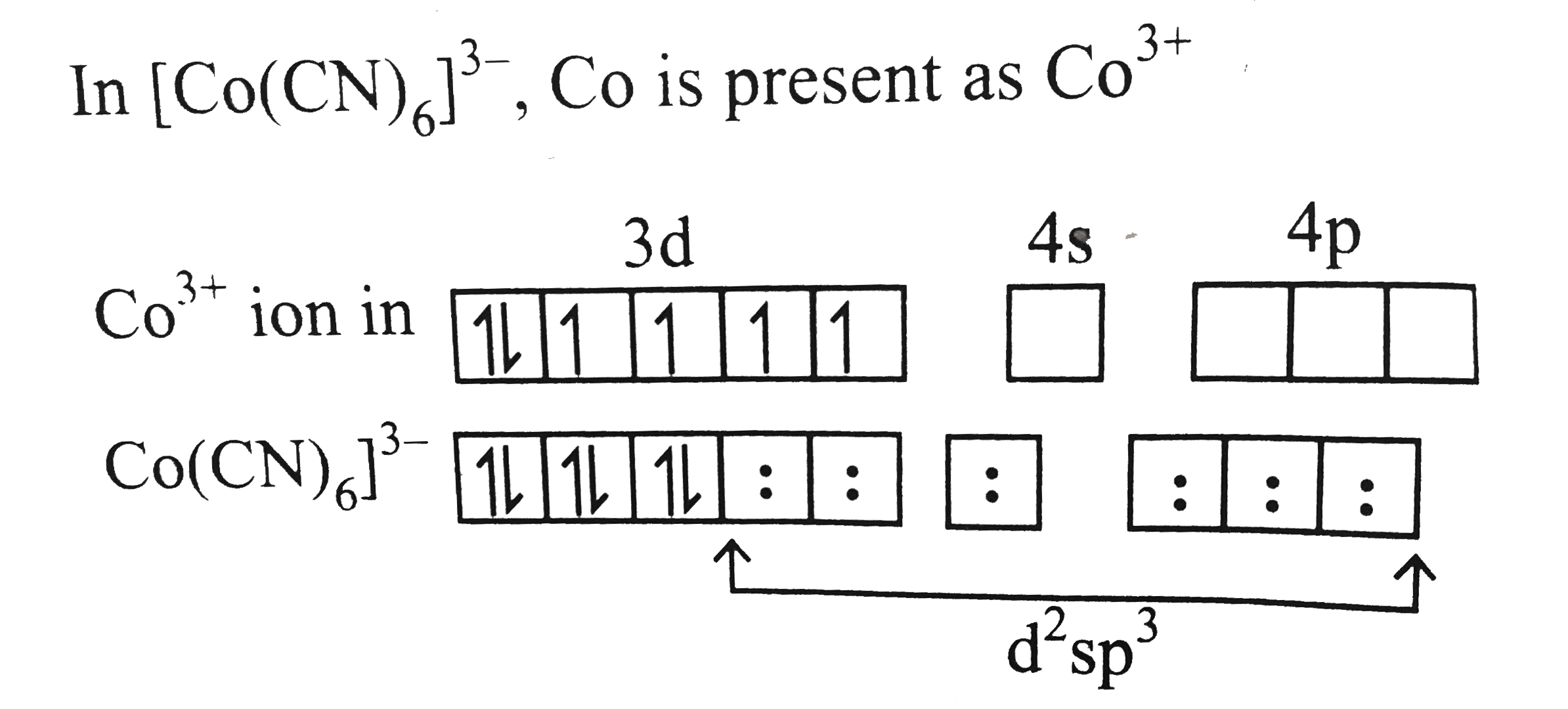Explain why a knowledge of magnetic suceptilbility of a complex is often necessary for a correct assignment of the electronic conifiguration according to valence bond theory
(b) Draw valence bond representations of the electronic structures of (i) [CoF6]3− (paramagnetic) and (ii) [Co(CN)6]3− (diamagnetic) .
Video Solution
Text Solution
Inner orbital complexes in which inner orbitals are involved d2sp3 or dsp2 or dsp3 electrons pairing is necessary in some cases The change in magnetic susceptibility moment is an indication of what orbitals are being used
(b) (i) Valence bond representation of [CoF6]3−
paramagetic Co is Co3+ ion in [CoF6]3−
[Co(Z=27)⇒3d74s2,Co3+⇒3d6]

Since [CoF6]3− is paramagntic electron Partiring will not take place and Co3+ ion will be sp2d2 hybridised forming outer orbital complex
(ii) Valence bond representation of [Co(CN)6]3− (diamagntic)
In [Co(CN)6]3− Co is present Co3+

Since the complex ion is diamagnetic pairing of electrons takes place resulting in Co3+ ion in [Co(CN)6]3− complex ion be to d2sp3 hybridised and hence forms inner orbital complex .
|
Updated on:21/07/2023
Topper's Solved these Questions
- BOOK - CENGAGE CHEMISTRYCHAPTER - COORDINATION COMPOUNDSEXERCISE - Ex 7.1 Subjective (Terminology)5videos
COORDINATION COMPOUNDS
- BOOK - CENGAGE CHEMISTRYCHAPTER - COORDINATION COMPOUNDSEXERCISE - Ex 7.1 Subjective (Effective Atomic Number (Ean))3videos
COORDINATION COMPOUNDS
- BOOK - CENGAGE CHEMISTRYCHAPTER - COORDINATION COMPOUNDSEXERCISE - Archives Subjective18videos
COORDINATION COMPOUNDS
- BOOK - CENGAGE CHEMISTRYCHAPTER - CHEMICAL KINETICSEXERCISE - Archives Subjective23videos
CHEMICAL KINETICS
- BOOK - CENGAGE CHEMISTRYCHAPTER - D AND F BLOCK ELEMENTSEXERCISE - Archives Subjective29videos
D AND F BLOCK ELEMENTS
Similar Questions
Knowledge Check
- Question 1 - Select One
For the correct assignment of electronic configuration of a complex, the valence bond theory often requires the measurement of
Amolar conductanceBoptical activityCmagnetic momentDdipole moment - Question 2 - Select One
For the correct assingment of electronic configuration of a complex, the valence bond theory often requires the measurement of :
Amolar conductanceBoptical activityCmagnetic momentDdipole moment - Question 3 - Select One
Tetraaminecopper (II) ion is a square planar complex with one unpaired electron. According to valence bond theory the hybrid state of copper should be
Asp3Bsp2Cdsp2DNone of above.
Using the valence bond approach, predict the shape and magnetic character of [Fe(CN)6]3− ion.
View SolutionOn the basis of valence bond theory, explain geometry, nature of hybridisation, magnetic property and optical isomerism of [Co(ox)3]3−and[CoF6]3−.
View SolutionOn the basis of valence bond theory explain the nature of bonding in [CoF6]3− ion. Write the IUPAC name of [Co(NO2)3(NH3)3].
View SolutionUsing the valence bond theory predict the geometry and magnetic behaviour of [CoF6]3−.
[At. no. of Co = 27]View SolutionDiscuss the geometry of the complex [Fe(CN)6]3− on the basis of valence bond theory.
View Solution

